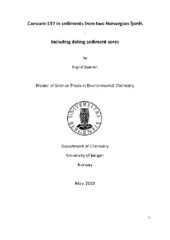| dc.description.abstract | Summary The fission product Cs-137 is present in all parts of the Norwegian environment, brought here atmospherically or by ocean currents. The most important sources are fallout from atmospheric nuclear weapons tests, discharges from nuclear fuel repossessing plants and fallout from the Chernobyl accident which have caused the presence of this radionuclide in the marine environment. The environmental presence of this radionuclide is thoroughly monitored, and the content in the Norwegian marine environment is relatively low. Earlier investigations have, however, shown elevated contents of Cs-137 in surface sediments from a few Norwegian fjords compared to the content in surface sediments from open marine areas. The fjords with elevated contents of Cs-137 are all connected to land areas which received relatively high amounts of fallout from the Chernobyl accident in 1986. In this work the Cs-137 activity concentrations in 14 sediment cores from the outlet and the head of the Laksefjord and the Sognefjord, have been investigated. Using the lead-210 dating method with correction of supported lead-210, each one-centimeter-layer in 11 of the cores has been dated. The Cs-137 activity concentrations in the upper sediment-layer from all 14 cores show Cs-137 content of three different levels. In the outlet of the Sognefjord the Cs-137 level (approximately 33 Bq/kg (d.w.)) is about 6 times above the level (approximately 5.8 Bq/kg (d.w.)) in the Laksefjord. In the head of the Sognefjord the Cs-137 level (approximately 293 Bq/kg (d.w.)) is about 10 times above the level in the outlet of the Sognefjord. In all cores analyzed, the Cs-137 activity concentrations in the upper layers are highest. This indicates a continuous supply of Cs-137 in the ocean currents or of Cs-137 in run-off from land. There are no specific signals in the dated sediment layers indicating which of the main sources is the dominating. It is likely to believe that the Sognefjord which is much deeper than the areas outside the fjord can accumulate Cs-137 from ocean currents and run-off. Chernobyl fallout on the land area surrounding the head of the Sognefjord is most likely the source to the elevated contents of Cs-137 there. The Cs-137 can be focused in the head of fjords due to the ratio between the drain-off area and the area receiving the drain-off. There are also elevated contents of Cs-137 in some other Norwegian fjords. These fjords are also located in areas which received a large amount of Chernobyl fallout. Fjords located in areas which received a relatively moderate amount of Chernobyl fallout does not show these elevated levels. | en_US |
